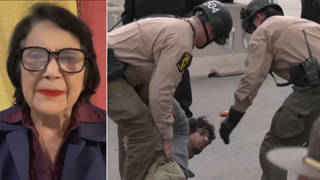
Last week, Virginia Governor James Gilmore ordered new DNA tests that could end the uncertainty over whether a retarded man committed the rape and murder that has kept him behind bars for over seventeen years. [includes rush transcript]
Earl Washington, Jr. was sentenced to death for the 1982 stabbing of Rebecca Lynn Williams. But the governor at the time, Douglas Wilder, commuted the sentence to life in prison because of doubts about his guilt. A 1993 DNA test of fluids from Williams’s body found genetic material that did not belong to either Williams or Washington.
Well, Gilmore’s decision comes at a time when the death penalty is being placed under greater scrutiny. There is a growing concern that innocent people are being put to death. Texas Governor George W. Bush just ordered a thirty-day reprieve for Ricky McGinn. McGinn, who was found guilty of raping and killing his twelve-year-old stepdaughter, will have an opportunity to prove his innocence through advanced DNA testing. And Illinois Governor George Ryan has placed a moratorium on all executions in his state, after learning that more death row prisoners have been freed than executed.
Guest:
- Barry Scheck, attorney and co-founder of the Innocence Project at the Cardozo School of Law in New York. He is also co-author of the book ??Actual Innocence: Five Days to Execution and Other Dispatches From the Wrongly Convicted.
- Jim Dwyer, columnist for the New York Daily News and co-author of ??Actual Innocence.
- Eric Freedman, professor at Hofstra University and attorney for Earl Washington, Jr. Freedman is an expert on the death penalty.
Transcript
AMY GOODMAN:
Last week, Virginia Governor James Gilmore ordered new DNA tests that could end the uncertainty over whether a retarded man committed the rape and murder that has kept him behind bars for over seventeen years.
Earl Washington, Jr. was sentenced to death for the 1982 stabbing of Rebecca Lynn Williams. But the governor at the time, Douglas Wilder, commuted the sentence to life in prison because of doubts about his guilt. A ’93 DNA test of fluids from Williams’s body found genetic material that did not belong to either Williams or Washington.
Well, Gilmore’s decision comes at a time when the death penalty is being placed under ever-greater scrutiny. There’s a growing concern that innocent people are being put to death. Texas Governor George W. Bush just ordered a thirty-day reprieve for Ricky McGinn. McGinn, who was found guilty of raping and killing his twelve-year-old stepdaughter, will have an opportunity to prove his innocence through advanced DNA testing. This came after attorney Barry Scheck said that if George Bush did not grant the thirty-day reprieve of McGinn to be tested before he was executed, that Scheck would have, at personal expense, him DNA-tested after he was killed. And Illinois Governor George Ryan has placed a moratorium on all executions in his state, after more death row prisoners have been freed than executed.
We’re joined now by Barry Scheck, attorney and co-founder of the Innocence Project at the Cardozo School of Law in New York and also co-author of a new book called Actual Innocence: Five Days to Execution and Other Dispatches from the Wrongly Convicted. We’re also joined by Jim Dwyer, columnist for the New York Daily News, winner of two Pulitzer Prizes, and co-author of Actual Innocence. We welcome you both to Democracy Now!
BARRY SCHECK:
Hi, Amy. Glad to be here.
JUAN GONZALEZ:
Well, Barry, tell us about the DNA testing and how it is changing the whole nature of the — how people in prison now who have been convicted are being exonerated.
BARRY SCHECK:
It’s pretty simple, that DNA testing, which was not available when these people were convicted, or even earlier generations of DNA tests that are not nearly as discriminating or powerful as the tests we have today, you know, can be used to look at cases that are twenty or thirty years old and prove that people did not commit the crimes that people thought they did.
I mean, take the case of Earl Washington that you discussed. You know, Earl Washington was a mentally retarded — borderline mentally retarded guy in Washington — in Virginia. And there were four rapes and a rape-homicide in a small town, and the police came upon Earl Washington involved in some kind of misdemeanor affair. They brought him in, and he was more than willing to confess to all these crimes, and typical in some ways of problems that we outline in Actual Innocence in the criminal justice system; in this instance, bad lawyers and false confessions. We have a chapter on each issue.
Washington got a good lawyer, actually, for the four rapes. Somebody was able to easily demonstrate that he couldn’t have committed those crimes. But he got a terrible lawyer on the rape-homicide, which is not surprising, since I think at that time in the state of Virginia they were giving $1,500 and maybe up to $2,000 for a lawyer to try a death penalty case. And unfortunately the people were not up to the task. In that instance, the lawyer overlooked the fact that even in an era when you used ABO typing to look at stains on a sheet, that Washington was even excluded by the ABO testing. The lawyer didn’t even realize it. In any event, he is convicted. He’s sentenced to death.
There is a wonderful Frontline that is going to be broadcast on June 13th called “The Case for Innocence” by the documentary filmmaker Ofra Bikel, and it’s —- one of the cases profiled in that piece is Earl Washington. You’ll see it there. But Governor Wilder, frankly, should have, based on the evidence that we presented to him then, he should have given Earl a pardon. The DNA tests really do show that he’s innocent, probably innocent, but -—
AMY GOODMAN:
Barry Scheck, we’re also joined by Eric Freedman, who is a lawyer in Earl Washington’s case. What do you think ultimately, Eric Freedman, turned Virginia Governor James Gilmore around to order these new DNA tests?
ERIC FREEDMAN:
I think that politicians are beginning to realize what Barry has said, which is DNA may be their last gasp at trying to rescue a failed system. After Earl Washington was charged with sex crimes, because — although, as Barry said, it was a misdemeanor — he was black, the victim was white, so they decided that it must have been an attempted rape. Then, because he was mentally retarded, he confessed. Because he had a lousy lawyer, the jury convicted him.
Now, maybe DNA will show what a decent system would have shown all along, that he never should have been in and will be released. Governors and other people who want to save the system are likely in, you know, some cases to succeed in getting press, and only a small fraction of them do, to try to vindicate the overall system by running the DNA tests and then saying, “Gee, you see what a wonderful system we have. We’ve let go innocent people.” But that is really covering up the structural nature of the system.
Earl Washington was incredibly lucky, first of all, that there is DNA to be tested. It happens to be a rape. If he had shot the victim from five feet, there wouldn’t be any DNA, or if whoever did the crime had shot the victim from five feet, there wouldn’t be any DNA, and Earl Washington would be dead now.
Furthermore, he had the very good luck to attract a very large team of talented national people who are doing this for no money whatsoever, and not just lawyers like Barry Scheck, but Henry Lee, a national leading DNA expert from Connecticut; Ruth Luckasson, mental retardation expert from New Mexico; Marie Deans of Virginia, who is one of the leading people in the country on gathering mitigation evidence; plus a whole lot of lawyers, all of whom, for millions of dollars in uncompensated work, managed to fix a system that got him convicted very quickly, but so far, in seventeen years, hasn’t released him.
JUAN GONZALEZ:
Well, Jim Dwyer — I’d like to ask Jim Dwyer, my co-worker at the New York Daily News and a wonderful columnist, co-writer of Actual Innocence, can you tell us a little bit in terms of some of the cases that you focused on in the book that demonstrate the enormous problems with some of these death penalty convictions in the areas that Barry mentioned, like attorneys and other areas where the system just failed defendants?
JIM DWYER:
Thanks, Juan. I think the most interesting thing about DNA is not DNA. It’s actually pretty trivial as our co-author Peter Neufeld often says. It’s a trivial solution that has enormous power in terms of exposing other problems. So we have in the book dramatic stories that happened to ordinary people who fell into the hands of the criminal justice system through all kinds of common errors.
So, for instance, a young man named Tony Snyder was washing his car one afternoon in his parent’s driveway, and across the street a woman was sitting on her couch looking out the window and happened to see Snyder and looked at him and said, “I know that face. I know that guy. That’s the guy who did it.” And she said, “I’ve seen him. I’ve seen him before. I know that it’s him.” Well, she had seen him before. Earlier, the woman had been — who had been the victim of a rape in her home — had been down at the police precinct in Alexandria, Virginia, and was shown a series of photographs of young black men who lived in her neighborhood. Now, Tony Snyder had done nothing more than get a ticket one time for playing basketball after-hours in a schoolyard, but the cops had his picture, she saw it, she didn’t pick him out then, but when she saw his face later that day, that was the image that was in her mind. So, consequently, the most common error of all, eyewitness error, led to Tony’s incarceration for forty-five years, also in Virginia, just like Earl Washington.
So, over and over, what DNA shows is not the power of DNA. It shows us the weakness of our traditional techniques. And one of the things we attack in the book — I mean, you have false confessions, which is very, very likely to have been the case in Earl Washington’s prosecution, [inaudible] science, where they use incredibly ridiculous techniques to buttress weak cases. So, for instance, there was actually a dog brought in in effect to testify in Texas, allegedly having smelled a suspect’s scent at a murder scene ten days after the fact, and the judge asked for the dog to do a demonstration in court of this, and the dog couldn’t even smell a can of Alpo, much less the murder suspect.
So you have all these types of problems that are exposed, and when they get the light of day, as they do through these DNA tests, then you have to ask the question, “How do you fix them?” One of the things we do in the book, besides going through a series of dramatic stories that illustrate each of these problems, is try and come up with the best available techniques to do better eyewitness identifications, to protect the integrity of interrogations so you don’t have false or coerced confessions, to improve the standards of science in the laboratory so that you don’t have junk science becoming the lynchpin of cases, and you’ve also got to look at the performance of attorneys, both prosecution and defense attorneys.
No lawyer in this country has ever gotten in trouble, in serious trouble, for walking his client, an innocent man, onto death row. But lawyers do get in trouble for misspending real estate escrow funds and misusing their client’s funds, which of course is serious issues. But they’re treated as, in a sense, the most grave crime that the disbarring system has for defense lawyers, as opposed to not doing a good job, as opposed to sleeping through a case when your client’s life is at stake.
So that’s why we wrote Actual Innocence, really, was not to talk about DNA, as much as to talk about what a friend of mine who’s a prosecutor describes as the old Green Bay Packer football system, the old traditional techniques of blocking and tackling. That’s what makes up the criminal justice system, not high-tech evidence, but low-tech, fundamental stuff, and that’s got to be fixed.
AMY GOODMAN:
Let me ask Barry Scheck, who, with Peter Neufeld, began the Innocence Project back at Cardozo Law School in New York. You’ve helped to free dozens of wrongly convicted people. You’re taking up the cause of hundreds more. How did you get started? How did you first establish this project?
BARRY SCHECK:
Well, actually, we recount this story in Actual Innocence. We — I’ve been a law professor for twenty-three years, and Peter and I used to work together as public defenders in the South Bronx. And our old office referred a case in 1987, ’88, of a guy named Marion Coakley, who was convicted of a rape-robbery, but had eleven alibi witnesses he was at a prayer meeting. Everybody thought he was innocent. And so, we took up the case, and the first thing we tried to do was DNA, and it actually turned out that there wasn’t enough DNA to get a result, but it was the very beginning of the technology.
Now, we managed to prove Marion innocent other ways that we sort of describe in the book, but we then, you know, started a forum in the law school. We learned a lot about DNA technology, and really our efforts have been dedicated to sort of using this technology to improve law enforcement as a whole ever since then. And so, really, starting right away, as soon as the technology was available, we always knew that this would not only exonerate the innocent, which it has done a lot, but if used correctly — and there’s been some problems with that, but we’re now getting it down a lot better — if used correctly, it also identifies the guilty.
And, you see, that’s every reform that we advocate in Actual Innocence, as Jim mentioned, you know, mistaken ID, false confessions, junk forensic science, fraudulent forensic science, bad lawyers, prosecutorial police misconduct, and on it goes. Each chapter tells a story, but it also gives a reform that is a win-win for the criminal justice system, because when you clean up ID procedures — and there are good ways to do it that people don’t focus on — you not only can exonerate an innocent person, but you also have an opportunity to catch the guilty before the guilty person commits more crimes.
And so, the things we’re saying here are being received by thoughtful conservatives, I mean, George Will, you know, read our book and said, “You know, these guys are right. The criminal justice system is just another government program, conservatives. You’ve got to look at it that way.” And so it goes. I mean, so I’m really hopeful that this is the start of going beyond, you know, a superficial look.
DNA’s real significance is that it can prove people definitively innocent or guilty, but it also is giving us an unprecedented opportunity to see the real state of the criminal justice system, and it is broken in so many places, and so broken that governors like George Ryan acknowledge that you really can’t really depend on it at this point, and probably ever, to make, you know, the kind of determinations that are necessary for the death penalty.
JIM DWYER:
One interesting thing that came up last week, you know —
AMY GOODMAN:
Jim Dwyer.
JIM DWYER:
Yeah, we all know about Governor Bush granting a thirty-day reprieve to a man in Texas named Ricky McGinn, so that he can have DNA tests. Now, whatever the politics are behind that decision, let’s look at what actually happened in the justice system. Governor Bush’s mantra has been that every person should have full access to the courts, that every person he’s executed has had full access to the courts.
Ricky McGinn had full access to the courts, and even though the trial court in that case said McGinn should have these advanced DNA tests that can definitively establish whether he’s guilty of capital murder, even though the trial courts said that, the Texas Criminal Court of Appeals denied it without explanation just the day before he was to be executed. That’s why Bush had to step in. What is the Texas Criminal Court of Appeals doing? It’s doing the same thing that courts of appeals are doing all over the country. In the cases we recount in Actual Innocence, none of those people actually got relief from the appellate courts, even though there were terrible eyewitness procedures, even though there were false confessions.
AMY GOODMAN:
Jim Dwyer, we have to break for stations to identify themselves, but we’re going to come back to this issue. And also, was that the reason George W. Bush gave the reprieve? Or was it because Barry Scheck said, at his own personal expense, if he didn’t grant the reprieve so that there could be a DNA test, he’d have him tested after he was executed, and George W. Bush takes great pride in saying that everyone that he has had executed in Texas — he has presided over more executions than any governor in the history of the United States — has been guilty?
We’re talking to Barry Scheck and Jim Dwyer, co-authors of Actual Innocence: Five Days to Execution and Other Dispatches from the Wrongly Convicted. They wrote the book with Peter Neufeld. Scheck and Neufeld became very famous when they were part of the O.J. Simpson defense team. And we were also joined by Eric Freedman, professor at Hofstra University, who is an attorney for Earl Washington, Jr., who has just been granted the ability to get a DNA test.
We’re also going to raise, when we come back, the issue of police taking DNA to form a greater database and the threats to civil liberties of this DNA database. You’re listening to Pacifica Radio’s Democracy Now! We’ll be back in a minute.
[break]
AMY GOODMAN:
You’re listening to Pacifica Radio’s Democracy Now! I’m Amy Goodman, with Juan Gonzalez. As we talk about DNA and the death penalty, our guests are Barry Scheck, a well-known attorney, who with Peter Neufeld founded the Innocence Project, and twice Pulitzer Prize-winning reporter Jim Dwyer. They’ve written a book together called Actual Innocence.
JUAN GONZALEZ:
Well, Barry, what about your challenge to G.W. Bush? Do you think it had any impact on him?
BARRY SCHECK:
You know, it’s — I don’t really think it’s — I don’t want to read his mind or do that kind of political calculation. Actually, you know, of course, I mean, I think he was — Howard Fineman had something in Newsweek, you know, that he got a more expansive briefing, and I don’t think there was much choice. I mean, you know, you don’t execute somebody when a DNA test could show they’re innocent, and if you begin to think about it seriously, if somebody’s in jail and they can prove innocence with a DNA test, then you give them the test.
And that’s the point of legislation that is now pending in Washington, and we’re going to have hearings now for the first time next week called the Innocence Protection Act, which has been introduced by Leahy of Vermont, a Democrat, and now Gordon Smith, a Republican conservative from Oregon, and in the House, Delahunt of Massachusetts, and LaHood, a Republican from Illinois. And the legislation would say, if you want to use a DNA databank in states — and everybody does and should — and you want federal money for it — and they all do — that you have to pass a statute like Illinois and New York. Illinois and New York are the only two states that say if an inmate could prove innocence or prove they were wrongfully sentenced with a DNA test, then you have a right to get the test, and if you can’t afford it, the state will pay for it. Guess what? Illinois has fourteen exonerations, New York has seven. Those are the two highest totals in the country. So, you know, we need that legislation.
Now, in regard to Bush, what wasn’t very well noticed is that on Wednesday of last week when he first announced that he was inclined to give McGinn a reprieve so he could get a DNA test, he also pardoned a man named A.B. Butler. A.B. Butler did close to seventeen years in jail for a crime he didn’t commit. DNA proved that. But most importantly, he spent seven years trying to get that DNA test, and he couldn’t, because there was no recourse in the Texas courts. All the time limits had passed for making motions for new evidence, which in thirty-three states is six months or less, so he just couldn’t get the test, and finally some prosecutor relented and consented, and that’s not the way the system would have worked. You would have a right to prove innocence, because, you know, sometimes the prosecutors are fair about it, and sometimes they may have been involved in, you know, putting you there wrongfully.
So, you know, this legislation is very important as a first step to helping exonerate the innocent, but again, as we’re emphasizing, you know, that just deals with the cases where there’s biological evidence. What about all those other cases where there isn’t? And what about all those other causes of wrongful conviction that we outline in Actual Innocence?
JUAN GONZALEZ:
Well, I’d like to ask Eric Freedman, the professor at Hofstra University and an expert on the death penalty, what impact has the work that Barry Scheck and Peter Neufeld have done with the Innocence Project and the publication of this book — what impact has this had on the debate nationwide in both the legal community and the general public over the death penalty?
ERIC FREEDMAN:
There’s no question whatsoever that following first on the conference two years ago in which a number of — like thirty-five — people who had been released from death row appeared on a stage in Chicago together to sort of dramatize this problem, and followed up with this book, the publicity given to the Actual Innocence cases has focused attention on the death penalty, because obviously there was nobody — you know, conservative, liberal, anybody — who thinks you should execute people who didn’t do the crime, and that’s, as Justice Blackmun said long ago, perilously close to simple murder.
So, raising the innocence issue, we all hope, brings visibility to the overall underlying problems. And the underlying problems are, first of all, as was said, you can’t get relief through the court system, and indeed, just two days ago, the Fourth Circuit Federal Court in Virginia has denied an attempt by someone named Derek Barnabei, who is scheduled to be executed and says that DNA would exonerate him. The courts said, no, sorry, and that’s what they said to Earl Washington, too. As far as the federal courts are concerned, Earl Washington would be dead.
So unless you happen, for whatever reason, to catch the sympathy of a governor, you are in desperate shape, unless this legislation that Senator Leahy is sponsoring goes through, and that’s why it’s very important that, for the hearings on it next Tuesday, people express their support, because that legislation, in addition to getting people DNA testing, will also address some of these underlying problems that compose the standards with respect to counsel, objects to the execution of the mentally retarded and people who were juveniles. It begins to address — it requires a study on race, so it begins to address some of the system-wide problems. And the danger is that the focus on innocence and DNA will allow people to do sort of a quick and dirty fix of a little bit of the problem and fail to go for systematic reforms, and that would be a tragedy.
AMY GOODMAN:
Professor Freedman, you say no one wants to execute an innocent person, and yet this whole idea of actual innocence no longer being a defense.
ERIC FREEDMAN:
Yes. The problem is that, although, of course, if you asked any responsible person, “Do you want to execute an innocent person?” they will say, “No, of course not.” Now, good, what are you going to do about it? Are you going to spend money on counsel? Are you going to tape record your confessions? Are you going to give people DNA tests? Oh, well, we have a thousand reasons why we won’t do those things. So, sure, we support it in principle, but in practice we shut our eyes to it, and the terrible offenders here have been the courts, sort of egged on by Congress, which very much restricted access to the courts in 1996, and then you get Bush being able to say, “Well, people have access to the courts.”
Well, Earl Washington had access to the courts only because, a week before his execution, a large New York law firm, where I then was, put in countless hours to compile a 1,200-page petition. And the attorney general of Virginia said, “Well, if no petition had been filed on his behalf, of course he would have been executed.” He had access to the courts, because people subsidized their inadequate death penalty system by volunteering, and eventually the Supreme Court, when all that was challenged, said, “Well, you know, there’s no proof that anybody has actually been denied access to the courts.” Why not? Because the ones who were denied access to the courts have been executed, and if they’re executed, they can’t bring cases to the Supreme Court. So this is why we’re saying that there are really system-wide problems that have to be addressed, and DNA and innocence are very valuable at putting a window onto that, but shouldn’t distract us from the real underlying problems.












Media Options